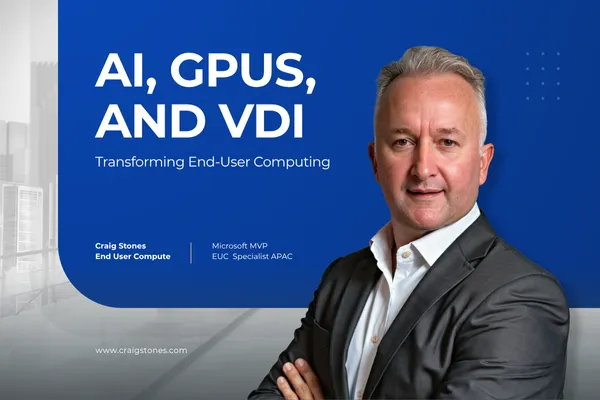
AI, GPUs, and VDI: Transforming End-User Computing
The intersection of GPUs, AI, and VDI is more than just a collision of technologies; it's a space of incredible innovation. The conversations I'm having with customers and industry leaders all point to one thing: AI is not just a trend, it's the next great disruption, and VDI is a perfect vehicle to deliver its power securely and efficiently.
I recently had the privilege of discussing this very topic with a panel of experts from NVIDIA, Citrix, Parallels, Google, AWS, and Nutanix. The energy and insights from that conversation were too valuable not to share, as we're all navigating this new landscape together.
The Big Question: Why AI in VDI?
Smaller organisations and large enterprises alike are keen to get their hands dirty with AI development and prototyping. The challenge has always been access to the high-end GPU infrastructure needed to get started. This is where VDI, something many organisations already have, becomes a powerful enabler.
By virtualising GPUs with technologies like NVIDIA's vGPU and the AI Virtual Workstation, we can simply spin up a VM and hand it off to an AI developer. It's a remarkably easy entry point for companies to start exploring AI without a massive upfront investment. Many businesses already have vGPUs in their infrastructure from recent refreshes, making the barrier to entry lower than ever.
Security: The Unsung Hero of AI Development
One of the most critical aspects of using VDI for AI development is security. For years, we've known that VDI provides more opportunities to add security layers and protect intellectual property. This is especially true for organisations that outsource development to third-party contractors. You simply don't want your source code sitting on unsecured endpoints.
VDI creates a secure software development lifecycle environment. It ensures that as companies build the next generation of AI applications, their IP remains protected. This isn't just a "nice-to-have"; it's a fundamental requirement for innovation.
How is AI Reshaping the Tools We Use?
The influence of AI is extending far beyond development. We're seeing it embedded directly into the products we rely on daily.
● Citrix is leveraging AI for protocol enhancements, like upscaling graphics to deliver full visual fidelity over restricted bandwidth. Their Co-pilot gives admins the ability to ask natural language questions about their entire Citrix estate, from user login issues to infrastructure assessments.
● Parallels has been recognised as a major player in AI-enabled application streaming, highlighting how the application landscape is changing. Their focus on secure, containerised browser sessions ensures that as AI agents begin to use applications, data sovereignty and compliance are maintained.
● Omnissa is taking a useful-first approach with its AI-powered Omni assistant and the introduction of the Omnissa AI agentic service, an assistant for administrators that not only identifies issues but also performs root cause analysis. The goal is to move from analysis to action, automatically creating service tickets or even texting a user to offer help.
The Rise of the AI Agent
Perhaps the most forward-thinking concept is the computer use agent—think RPA on steroids. These AI agents can emulate human interaction with applications purely through computer vision, automating complex workflows.
This is where the collective expertise of the EUC community becomes invaluable. We understand how to secure and manage end-users, and soon, AI agents will be treated just like any other user on the network. The skills we've honed over decades in managing connectivity, settings, and security for human users will be directly applicable to managing these new AI workers.
A Pragmatic Approach to a New Frontier
With all the buzz around AI, it's easy to get lost in the hype. The advice from across the industry is consistent: have a clear outcome in mind. AI for AI's sake is just research. For it to be valuable in business, it needs to solve a real problem or improve a specific process.
This is just another disruption in a long line of disruptions our industry has faced. From mainframes to the cloud, we've adapted and evolved. The key is to embrace it early, learn as much as you can, and dive in. We, as IT professionals, will stay relevant by being the ones who implement, support, and secure this transformative technology.
The future of end-user computing won't look anything like what we recognise today, and that's an exciting prospect.
What are your thoughts on how AI will shape your IT environment? Let's start a conversation.
